Raw Material Beef Tallow From Canada
Introduction
ane.one. General remarks
"Animal fats are a by-production of the whole meat concatenation." While this start judgement sounds quite elementary it includes nevertheless two important facts:
- Animal fats are non produced as such. They are only produced in relation to the raising of animals for meat, eggs, milk or wool production. Animal fats are a side, co- or by-product of the production of another animal product.
- The volume of animal fats increases with an increasing production of meat, eggs, milk or wool, only their production won't increment with an increasing need for fauna fats. Animals are not raised for animate being fats similar oilseeds are planted for vegetable oil.
Another deviation to oilseeds is that, similar fish oil production, the processing of animate being by-products always includes a thermal processing (melting) pace; common cold processing is not possible.
There are 2 general categories of animal fats: edible and inedible. Furthermore, the European Wedlock categorised the inedible fats in three unlike risk categories. Some other fat volition be included in this chapter: Used cooking oils (UCO)/Yellowish Grease (YG) and Dark-brown Grease (BG), even though these fats consist mainly of vegetable oils. The collection and handling of these fats are often in the portfolio of the renderers' business, rather than in that of the vegetable oil producers.
Despite the fact that milk and milk products and fish and fish by-products are also animal past-products, their processing will exist dealt with in a split up chapter.
one.ii. History
The history of rendering can be approached from dissimilar angles. Since Roman times the art of soap making from ash and rendered fat has been well known. Other applications for animal fats, such as candle making from cattle and sheep tallow, came afterwards. In the middle of the 19th century the rendering process became industrial equally well. Rendering in open up pans over open up fires evolved into a safer airtight vessel system.
Some other aspect was that as cities in Europe grew, a arrangement of dead livestock collection and treatment or disposal outside the urban center walls was established for sanitary reasons. While in the Middle Ages skinning of animals for their hides and skins and mayhap the production of baits for wolf hunting was the only economic benefit for the knacker, rendering animal by-products for protein and fat now became more than bonny than but disposing of the carcasses. At the terminate of the 19th century this proteinaceous past-production was recognised to exist of value besides. Get-go used as a fertiliser, information technology was shortly used as a protein feed compound.
Today information technology is unclear whether rendering was adult from the rendering of fat and bones from slaughtered or hunted animals or due to the need to handle increasing volumes of expressionless livestock and slaughter by-products exterior growing cities. But it must be acknowledged that rendering brute by-products was, is and will be one of the nigh of import steps in beast affliction prevention. Considering animal by-products tend to deteriorate chop-chop since they are a nutrient-rich civilisation medium for all kind of pathogens, improper treatment leads to severe problems with fauna diseases and zoonoses. The OIE (Function International des Epizooties) acknowledged rendering as the safest, most practical mode of dead livestock disposal [one,2].
It can exist concluded that rendering can be seen equally one of the oldest recycling systems in human history. Information technology is fully industrialised today and fauna fats and animal proteins are agricultural bolt worldwide.
Animal fats tin exist distinguished between edible fats and inedible fats. Non all edible fats are used in human consumption considering certain qualities are needed in feed, pet nutrient or the oleochemical industry. On the other hand inedible fats are not allowed in human consumption any more than. They tin can only be used in feed, pet food, oleochemistry, biodiesel or to generate energy. Edible fats which have already been used in nutrient frying processes, called 'Used Cooking Oils' or 'Yellow Grease', as well as the fatty phase from the grease trap, the then called 'Brown Grease', are also inedible fats.
i.iii. Markets
Tabular array 1 and Figures ane-three show the volumes and usage of animate being fat in the key markets of Australia, Eu, Brazil and Us/Canada.
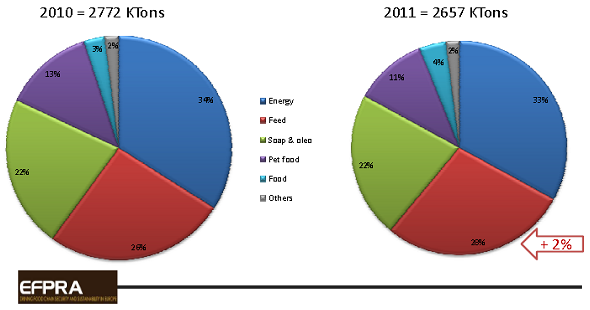
Figure ane. Volume and destination of animal fat produced in EU20 (about two/three of the free energy uses is dedicated to biodiesel) [3]. All figures were supplied courtesy of EFPRA.
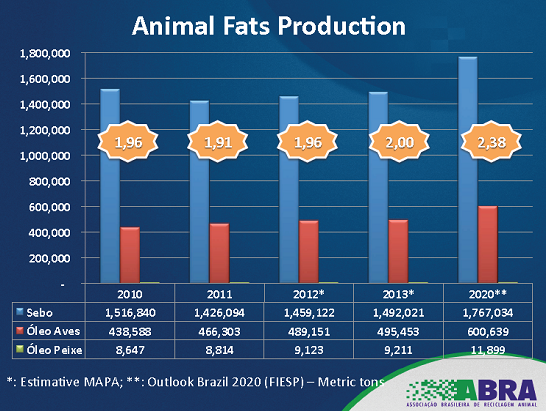
Figure 2. Production of animal fat (Sebo), poultry fat (Óleo aves) and fish oil (Óleo peixe) in Brazil [4].
| Tabular array one. Production of creature fats in Australia in 2011 | ||
| Commodity | Product ('000 tonnes) | |
| Tallow | 487.0 | |
| Poultry oil | 59.vii | |
| Full product - animal fats | 546.vii | |
| Exports | 362.2 | |
| Domestic oleochemical and industrial | 50 | |
| Domestic edible applications | 35.0 | |
| Domestic intensive fauna product | xl.0 | |
| Domestic aquaculture feeds | xviii.0 | |
| Domestic pet nutrient | 25.0 | |
| Domestic biodiesel and fuel | fifteen.0 | |
| Other | 1.5 | |
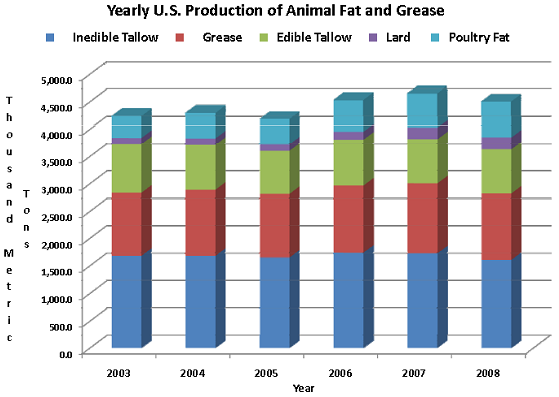
Effigy three. Yearly U.South. production of fauna fat and grease (NRA, www.nationalrenderers.org).
2. Raw materials
2.1. Edible fats
Edible fats are produced from fresh slaughter by-products that were declared fit for human being consumption after a veterinarian inspection and are all gained from healthy slaughtered animals. Their production is unremarkably species specific. Typical edible fats are beef tallow, pork lard, goose or duck fat.
Some beefiness tallow producers subdivide their production even farther, eastward.g. into adipose cloth from the abdomen (similar kidney fat) and subcutaneous fatty. Those beef tallows have unlike properties considering of their different fatty acid limerick.
Another edible fatty is produced during the gelatin process. Edible gelatin is mainly produced from pork and ruminant bones, pork skins and ruminant hide split. For the gelatin procedure these raw materials have to exist defatted. This fat is here a co-production of the gelatin industry.
2.2. Inedible fats
The main raw materials are ordinarily slaughter by-products that are fit for human consumption simply not destined for human consumption. They come up from slaughterhouses and cut plants and include blood, fats, bones, feet, horns, and innards like lungs, liver, and hearts. They can be sold for nutrient but due to changed eating habits peculiarly in the developed countries they may amount to nearly 50% of the slaughtered animal. Table 2 shows typical fractions of animate being products used in food and not destined for food. This large amount of by-products non going into food, is what slaughterhouses refer to as their "5th quarter".
| Table ii. Boilerplate proportion of meat and past-products in different species [6] | ||||
| Slaughtered animate being | Homo consumption (%) | Past-products (%) | ||
| Craven | 68 | 32 | ||
| Hog | 62 | 38 | ||
| Cow | 54 | 46 | ||
| Sheep/goat | 52 | 48 | ||
Non all animal by-products (ABP) are sent to rendering plants. Meat-rich past-products like lungs, liver and hearts are sold to wet pet nutrient plants. Ruminant hides are used for leather product. Blood is collected to produce plasma and haemoglobin fit for man consumption. Pancreas can be used for insulin production, and bones and pork skins are of import sources for gelatin manufacturing.
In developing countries this amount is naturally smaller and includes only inedible parts of the fauna. Inedible past-products include all slaughter by-products which are plainly not fit for human consumption like feathers, beard and horns or material that has been declared not fit for homo consumption after a veterinarian inspection at the slaughterhouse. These are, for case, infected meats, injured animals or legs, meat with haematoma or inflammation.
Inedible by-products also include all animals which happen to die on farms or were culled for fauna disease eradication, or animals which are not used for human being consumption, like zoo and circus animals, pets and fur animals. The sanitising process of rendering this expressionless livestock is a key chemical element in brute disease prevention. The collection and proper estrus handling of all these animals is an obligation in the European union. Elsewhere in the world, information technology is generally voluntary, i.eastward. disposal by composting, state filling, burning etc. is besides permitted. Other inedible fabric is for example eggshells, quondam foodstuff/outdated meat and specified adventure material (SRM).
2.2.one. Categorisation of brute past-products in the EU
In 2000, during the summit of the BSE crisis in the UK, the European Commission (EC) started to ready upwardly a white paper [vii] on food safety. Besides the foundation of an independent European Food Safety Authority (EFSA), the "farm to fork" arroyo was 1 of the central elements. It should guarantee rubber feed for safe food and the on-going eradication of animal diseases and zoonosis. In 2001 the TSE-Regulation [viii] was published to eradicate TSE (transmissible spongiform encephalopathy, umbrella term includes all SEs, i.eastward. too bovine also caprine, ovine, mink etc.). It includes inter alia monitoring programs, definitions of the specified take a chance materials, the electric current feed ban of fauna proteins to farmed animals. Simultaneously the EC started its piece of work on an Animate being-By-Production-Regulation (ABPR) that was finally published on iii.10.2002 [9]. This regulation is directly applicable in all Eu Fellow member States. In 2009/2011 it was revised to Animal by-products Regulation ABPR [10] and Animal by-products implementing Regulation ABP-IR [11].
The scope of the ABPR is the safe drove, treatment and employ of ABP, including full traceability at all stages. If the starting material is nutrient grade (edible fat) and produced in a food plant, the processing conditions have to comply with nutrient hygiene regulation 852/2004 [12] and specific rules on the hygiene of foodstuffs in regulation 853/2004 [13], even if they are finally sold for other purposes.
A key element of the new ABPR is the definition of ABP: "'animal by-products' means entire bodies or parts of animals, products of brute origin or other products obtained from animals, which are non intended for human consumption,..". The intention tin can exist "by law", i.e. the material is alleged not fit for homo consumption or "by determination", i.east. the material is no longer destined for human consumption. Both intentions are irreversible. In one case declared as ABP the material cannot re-enter the food chain.
The ABPR likewise divides the material into iii risk-based categories (Table three). Category 1 is the category with the highest take a chance of contamination. Heavy metals, persistent organic compounds like dioxins and PCB, or non-classical diseases like TSE cannot be sufficiently destroyed by normal rendering and should thus not be recycled into the food and feed chain. Category 2 poses a known and manageable take chances of diseases that can be reliably reduced by a sterilisation step. Recycling into technical products like fertiliser is allowed. Category 3 is the lowest adventure category. It includes mainly ABP fit for human consumption (but non destined for human consumption), and other ABP from healthy slaughtered animals, e.grand. feathers, beard, horns. Category 3 products can be used every bit beast feed (but not for human nutrient!). Catering waste including Used Cooking Oils (UCO) is considered to be category iii too just its use in feed is not allowed. With an increasing risk at that place are a decreasing number of different uses allowed. For a brief overview run into Table 3.
| Table 3. The permitted uses of different categories in the European union | ||||||||||||||||
| Category | Incineration | Combustion | Oleochemistry | Biodiesel | Biogas | Fertiliser | Feed | Pet nutrient | ||||||||
| 1 | 10 | X | X1 | X | Ten2 | |||||||||||
| 2 | Ten | X | Xone | X | X3 | X3 | ||||||||||
| 3 | 10 | X | X1 | 10 | 10iii | Ten3 | X | X | ||||||||
| UCO | X | X | 10 | X | Ten | |||||||||||
| 1 Merely for limited purposes (i.due east. no cosmetics, no pharmaceuticals, etc.). | ||||||||||||||||
two.2.2. Used cooking oil/Xanthous grease and Brown grease. Another raw textile already mentioned is used cooking oil (UCO), also known as yellowish grease, and trap or brown grease. Despite the fact that both contain mainly vegetable oils and less animal fatty, they should exist mentioned and explained here, because in many cases renderers handle them, i.due east. deal with collection, cleaning and trading.
-
UCO/Yellow Grease
UCO or Yellow Grease is the spent vegetable and/or animal fatty and oil from deep fryers in canteens, restaurants, fish & chip shops etc. and from deep frying food industries producing products like meat assurance or potato chips. After the deep frying the UCO is collected separately in bins or tanks, depending on the volumes. Outside the EU Yellowish Grease can be used as feed. Currently information technology is mainly used for the product of biofuel. -
Brown Grease/Trap Grease
Dark-brown grease is an emulsion of vegetable and animal oil, fatty, grease, solids and water. It is separated from the wastewater in a grease interceptor (grease trap) from where it tin can be nerveless for different purposes. In many countries these interceptors are obligatory for canteens, restaurants, supermarkets etc. Equally the dark-brown grease is all the same a water/oil emulsion with an undefined amount of impurities and (usually) high free fatty acid content, its utilize is very limited. Some countries let the utilise every bit feed. Other options are to use it as a substrate for biogas or wastewater treatment plants.
The websites of ii big American companies, Darling International, Inc. and Sanimax, give good overviews on the service and drove systems.
3. Processing
In general there are two different rendering systems established worldwide. Depending on whether the animate being fat is gained from an already dried material or from a wet phase, the systems are named dry and wet rendering, respectively. There is no full general dominion when and where wet or dry rendering is preferred, simply it can be observed that wet rendering is more often than not used where oestrus-sensitive, high-value products like fish oils, edible fats or poultry fats are produced.
The fat melting and rendering processes aim at 3 important goals -
- Removal of water to get stable products which are fat and solids, eastward.g. proteins
- Separation of the dry product into fatty and solids (protein)
- Sanitation, i.e. the reduction of possible pathogenic loads, which is the less of import the fresher the processed material is.
Some of the equipment used in the process is illustrated in Figures 4-vii and 9-10.
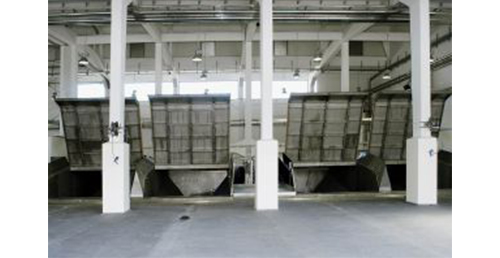
Figure 4. Reception bins.
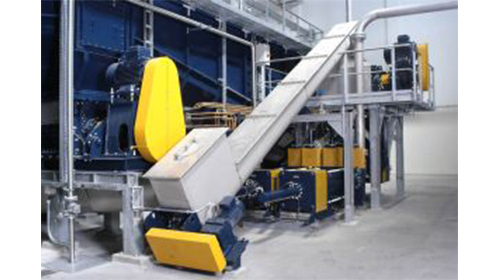
Figure 5. Breaker.
three.1. Moisture rendering
After size reduction in a crusher (mostly followed by a mincer), the raw textile is melted in a cooker either with direct steam or indirect heat. To avert damaging the nutritional values, this is carried out at the everyman temperature possible (70-xc°C). The separation of the iii phases (solids, aqueous stage and melted fatty) can be achieved by different techniques. The most common is drainage of the solid phase, which is later pressed and dried. The liquid phase is sent to a decanter (horizontal centrifuge) or tricanter. Decanters separate two phases, tricanters iii phases in one step. Solids from the decanter are dried together with the other solid phase. The liquid stage, the so-called stick water, is sent to the dryer, either directly or later on a concentration step in an evaporation unit of measurement. In some cases the liquid phase is full-bodied and dried separately into high-value, highly digestible proteins. The fatty is cleaned.
In nutrient plants the solids from a fatty melting plant can exist separated wet from the water phase and cooled. The wet cracklings (the unmelted residue afterward the fats take been melted) can be sold for human being consumption or pet nutrient. Figure 8 summarises the process.

Effigy 6. Cooker / Dryer.
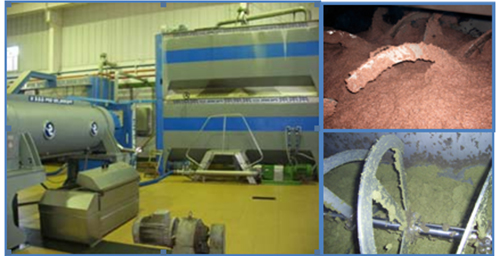
Figure 7. Decanter.
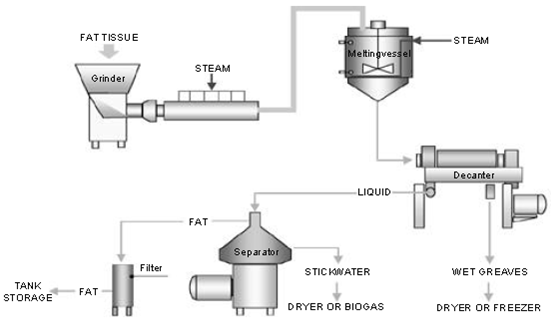
Effigy 8. General flow diagram of moisture rendering [xiv].
Moisture rendering is also used for the pre-processing of material for gelatin manufacturing. Bones, sinews or hibernate divide are defatted with hot water. The defatted products enter the gelatin process and the fat is separated from the water phase.
three.two. Dry rendering
After having been crushed, the cloth is cooked. This process tin can be continuous or discontinuous. Downstream of the cooker, the processes are mainly continuous. If the cooker does not include the drying step besides, a dryer volition follow. The cookers and dryers are mainly contact dryers. The ii main contact dryers are disc dryers and evaporation towers. Sometimes fat is added to the drying step to have a better rut transfer and to protect the poly peptide quality. The dried cloth is pressed to yield fat and solids. Effigy xi summarises the process.
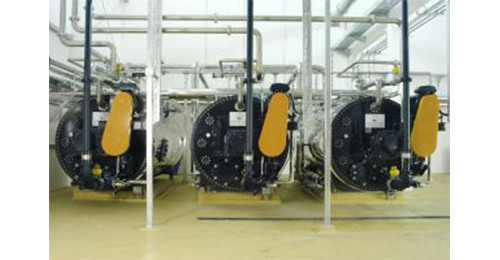
Effigy nine. Steriliser/cooker.

Figure 10. Presses.
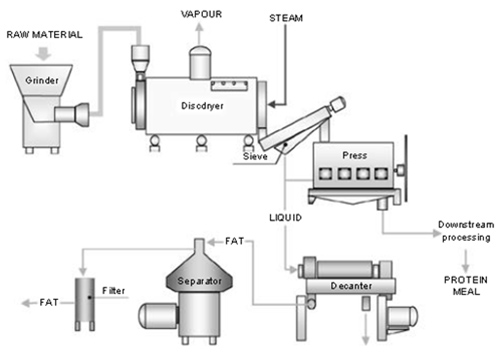
Figure eleven. Full general period diagram of dry rendering [14].
3.three. Milling
The solids are milled into meal after a cooling catamenia or active cooling. This procedure tin include a sieve to exclude foreign substances. Some plants use air classifiers to get different qualities. Table iv lists the backdrop of some solids fractions.
| Tabular array four. Typical qualities of different solids fractions (in weight %) | ||||||||||
| MBM/PAP1 | Poultry meal | Greaves meal | Plumage mealtwo | Blood repast2 | ||||||
| Protein | 45-65 | threescore-68 | lxxx-88 | 80-85 | xc-95 | |||||
| Fat | 12-xvi | 12-xvi | eleven-xiii | 7-11 | 1 | |||||
| Ash | 22-35 | 10-twenty | 3-6 | four-ten | 2-iii | |||||
| Phosphorus | 3-7 | ii-3 | 0.3-1.0 | 0.v | 0.2-i.0 | |||||
| Water | five-7 | 4-vii | iv-6 | 6-viii | 4-vii | |||||
| ane MBM = meat and bone meal; PAP = processed animal protein. two Blood and feathers do not contain high amounts of fat. Their processing does not comprise a fat separation step. | ||||||||||
3.four. Water treatment
The water is sent to a (municipal) wastewater treatment plant. Many big rendering companies treat their own wastewater because the remaining load (chemical and biological oxygen need (COD/BOD)) is too high and amounts to likewise many population equivalents. For advanced germ-free reasons some renderers decided or are obliged to burn down the evaporated water in thermo-oxidisers.
3.5. Fat treatment
Creature fat, whether it is produced by wet or dry out rendering, is cleaned in a separate footstep. Different methods can exist used either alone or in combination.
- Sieve
The installation of a sieve is often necessary when a high amount of fibres or plastics is expected. Small pieces of plastic in particular are very often a problem in further uses. The sieve can vary from a rotating screen to a cloth filter. - Sedimentation
This uncomplicated method is very frequently used. The fatty is stored in a tank with a conical bottom where the water phase including solid sediments separates by decantation. The sedimented phase is removed at the lesser. - Decanter
Decanters are horizontal centrifuges that remove water and solids very apace from the fat phase. - Separator
A separator is a vertical centrifuge. Due to higher speed and the stacked discs, the cleaning results are better than for the decanter. Separators are often used for last polishing of fats after the decanter. The most mutual is the (self-cleaning) disc separator. The awarding of water or acrid solution to amend the cleaning is possible. - Filter
Different filter techniques, eastward.yard. pre-glaze filters, can be used to remove solids.
Since the BSE crunch, ruminant fat should exist cleaned then that the amount of insoluble impurities does not exceed 0.xv%. Methods are defined past ISO (663:2007) and American Oil Chemists' Order Official Method (Ca.3a-46, 2009).
Due to the presence of free fatty acids and soaps, brownish and yellow grease can build very stable emulsions and so that it is often impossible to divide a clear fatty phase. Therefore, elementary techniques like sedimentation and sieving are the almost mutual techniques for separating water and bigger solids from these materials. Only yellow grease/UCO of a specified quality is accepted for the product of biofuels, which some producers refine themselves before using it. Brown grease has (due to its poor quality) but limited outlets, eastward.1000. production of biogas, water treatment plants.
The refining of animal fats (bleaching, steam stripping, etc.) as well every bit the extraction of fat from meals has already been described in other chapters of the Lipid Library. They are thus non repeated hither.
4. Quality
4.i. Quality factors
In add-on to the chief categories of edible and inedible fat, different uses require dissimilar qualities. This but means that dissimilar qualities must be guaranteed for food, feed or fuel uses. The chief quality specification parameters can be before long summarised every bit follows:
- Water: h2o content in the fat [%]; a too high h2o content leads to deterioration, i.eastward. hydrolysis, free fatty acids.
- Insoluble impurities: impurities left after a Soxhlet extraction [%].
- Free Fat Acids (FFA): indicates the degree of hydrolysis [weight % oleic acid].
- Iodine value: The IV indicates the unsaturation of the fatty acids. Fully saturated fats have an 4 = 0.
- Colour: should be feature.
- Smell: should be characteristic.
- Melting point.
- Fume signal: the temperature at which cooking fatty or oil begins to produce bluish smoke. Information technology varies between dissimilar fat sources and decreases with increasing FFA.
iv.2. Safety
In the by, rendered products were – amongst many others – affected by feed/food scandals. The most well-known are linked to BSE and dioxin. This increased the awareness on food and feed safety and led for example as a upshot to the implementation of HACCP control systems. It is near of import to realise that the processes described do non themselves lead to any contagion. If the raw textile is already contaminated, there is an inevitable concentration of contaminants in the rendering process simply by the removal of water. The h2o-soluble contaminants stay in the repast, the fat-soluble in the fatty. Whatever pollution originates thus from the raw material processed.
The production of edible fats has e'er been subjected to stringent safe systems. The raw material undergoes veterinary inspection at the slaughterhouse and has to be declared fit for homo consumption before the melting process.
Long ago creature by-products (ABP) had very often been considered as waste material. Some producers accustomed (or did not care nearly) the casual mixture with other waste, which was then sorted out by the renderer or past techniques like using metal detectors. Today this has changed. ABP are acknowledged as a past-product with a value which tin be maintained by proper handling.
Regarding animal fats, the physical risks are negligible. If we condone the unlikely risks, at that place are the following primary risks, which are regularly monitored and controlled:
Chemical risks: As most of the fabric rendered is from animals produced for human consumption, the fat rendered from this material therefore has the same take a chance level every bit regular food. Laboratory animals and zoo, circus and pet animals might receive chemical substances like medications, only the dosage and the fraction of these animals in the full raw textile stream are usually so depression that these substances are both negligible and under the detection limit. Furthermore in many countries these animals are not rendered simply disposed of. In the European union, fatty from these animals is only allowed for very restricted purposes like disposal by incineration, energy production by combustion, biofuel production, etc. Some chemicals, which cannot exist digested or excreted, accumulate in the creature's torso over the years even if present in the feed in depression concentrations. This has been observed for years in studies of different types of meat. But thanks to radical reduction of these substances in feed (in view of this accumulation over time), the load in the meat and thus in the ABP as well has been reduced in recent years.
The following chemical risks tin can be identified:
-
Heavy metals are regularly controlled by the food/meat industry and by the feed industry likewise so that it is highly unlikely that heavy metals are nowadays. In the past heavy metals were establish for example in animals grazing on contaminated land similar grasslands flooded by polluted rivers. Later the rendering process, heavy metals would remain in the solids.
-
Dioxin, dioxin-like polychlorobiphenyls (PCBs) are regularly checked by the food/meat industry and past the feed industry equally well so that their occurrence is highly unlikely. These Persistent Organic Pollutants (POP) are emitted past uncontrolled incineration, fires (houses or wood) or volcanic eruptions; therefore, they are ubiquitous. In addition to natural emissions, anthropogenic sources like industry emissions and traffic are the main sources. This means that extensively reared animals are more at risk in industrial areas than intensively reared animals in agronomical areas. As these POPs are fat soluble they accrue in the fat. But if the meat product is safe, the fat is not at risk. Moreover the fat is regularly monitored.
Biological risks:
-
Microbiological pathogens
All rendering processes are designed to destroy thermophilic pathogens during the sanitation processes. As pathogens are attracted to water, their occurrence in fatty is highly unlikely. -
Transmissible spongiform encephalopathy (TSE)/prions
First of all it must be stated that TSE infections are very rare but not negligible. Only a few countries reported bovine spongiform encephalopathy (BSE) cases: nineteen Eu member states, United states, Canada, Brazil, Japan, Israel, Principality of liechtenstein and Switzerland. To tackle this illness, the OIE classified countries in three unlike risk categories: Negligible, controlled and undetermined. 49 countries accept today a controlled or negligible run a risk. Prions are proteins; therefore, they practise not appear in the fat but in the solids, the MBM . Ane mensurate to eradicate TSE was to reduce the amount of insoluble impurities of fat from ruminants down to 0.15%. This fatty can still be used in feed, while the utilize of MBM in the feed of ruminants is forbidden.
iv.3. Fatty profiles
Depending on the species (e.g. poultry = duck, goose, chicken), different feeding methods (due east.grand. intensive or all-encompassing), and the different parts of the animals (east.thousand. os, peel, meat, etc.) the fatty acid contour can vary for the same product. Table 5 shows general properties for some species-specific animal fats.
| Tabular array five. Properties of different animal fats | ||||||||
| C atoms | Beefiness tallow | Pork lard | Poultry fat | |||||
| Melting point (°C) | xl-fifty | 34-44 | 23-40 | |||||
| Iodine value | 25-45 | 45-75 | 65-75 | |||||
| Fatty acrid composition | ||||||||
| Myristic acid | 2-3 | i-1.five | 1-one.5 | |||||
| Palmitic acid | 16 | 24-28 | 24-28 | 20-24 | ||||
| Stearic acid | 18 | 20-24 | xiii-xiv | 4-six | ||||
| Saturated fat acids (%) | 46-55 | 38-43.5 | 25-31.five | |||||
| Palmitoleic acrid | 16 | two-3 | 2-3 | 5-9 | ||||
| Oleic acid | 18 | 40-43 | 43-47 | 33-44 | ||||
| Linoleic acid | 18 | 2-4 | eight-11 | xviii-20 | ||||
| Linolenic cid | eighteen | <ane | <1 | 1-ii | ||||
| Unsaturated fatty acids (%) | 45-51 | 54-62 | 57-75 | |||||
Tabular array 6 gives a short overview of how the fatty acid profile can be different in different parts of pigs and cattle (own composition of industry information and literature, i.eastward. [15-17]).
| Tabular array 6. Fatty acrid profile of beef and pork fats | ||||||||
| Species - Type of Fat | Fat acids [weight %] | |||||||
| (location) | 16:0 | 18:0 | 18:ane | 18:2 | ||||
| Beef | ||||||||
| - Subcutaneous | 24.vi | xi.1 | 46.6 | i.7 | ||||
| - Intramuscular | 24.7 | 18.3 | 42.four | 1.9 | ||||
| - Kidney fat (suet) | 25.0 | 29.2 | 33.5 | ane.5 | ||||
| Pork | ||||||||
| - Back fat | 24.four | xvi.6 | 44.1 | 8.9 | ||||
| - Belly fat | 25.5 | 16.viii | 41.3 | 8.two | ||||
| - Intramuscular | 26.0 | 15.4 | 43.0 | vii.three | ||||
| - Leafage fat | 28.5 | 20.ane | 37.2 | 7.3 | ||||
The National Renderers Association (NRA) recognised and defined the post-obit categories:
Choice white grease – A specific form of mostly pork fat divers past hardness, colour, fatty acrid content, moisture, insolubles, unsaponifiables, and free fat acids.
Edible tallow – Exclusively beef, this product is rendered from fat trimmings and bones taken from further processing at a slaughterhouse. The product is of light color and low wet, insolubles, unsaponifiables, and free fatty acids. The tallow may be further refined, polished, and deodorized to become a cooking fat. The pet food industry more often than not uses the crude product not shipped under seal, oftentimes referred to as technical tallow.
Edible – Fats and proteins produced for human being consumption, which are under the inspection and processing standards established past the US Section of Agriculture, Food and Safe Inspection Service (USDA/FSIS).
Fat products – Tallow and grease.
Feed grade beast fatty – Also known as "Fat product, feed grade" is any fat production which does not meet the definitions for beast fat, vegetable fat or oil, hydrolysed fatty or fatty ester. It must be sold on its specifications which will include the minimum percent of total fatty acids, the maximum percent of unsaponifiable matter, the maximum pct of insoluble impurities, the maximum percentage of gratis fatty acids and moisture.
Inedible – Fats and proteins produced for animal, poultry, and fish consumption or for other nonedible uses.
Lard – Edible grease, the process and parameters of which are the same as for edible beef tallow, but with pork as the raw material.
Poultry fat – Animal fat produced from poultry.
Tallow – Primarily from beef fatty, defined by hardness, moisture, insolubles, unsaponifiables, free fatty acids, fatty acid compositions, and colour with a titer of 40.0°C or higher.
Yellow grease – This fabric is unremarkably made upward of restaurant greases (fats and oils from cooking). Another source could exist from rendering plants producing lower-quality tallow, fats, and greases.
4.4. Other animate being fats
Besides the above described animal fats, there are another fats which do not fall under the heading "fatty melting and rendering", as they are gained by other processes.
-
Butterfat/antiseptic butter
Butter is a water-in-oil emulsion resulting from an inversion of the cream, an oil-in-water emulsion. Melting butter produces antiseptic butter or ghee, which is near entirely butterfat. Butterfat can be produced from milk from any species. Clarified butter tin have different regional names: Samna (Centre East) or Ghee (S Asia). -
Wool fat/wool wax/lanolin
Wool fat can be separated from water used to launder the wool. Despite the yet often used name wool fat it is non a "fatty" considering information technology consists of wax. The correct name wool wax should therefore be used. Lanolin may contain alkane oil and h2o. Its application is by and large in pharmaceutics/skin care.
v. Markets
Depending on the quality and safety of the fatty there are different markets worldwide for fauna fats. There are in general three different qualities: nutrient form, feed grade or for technical purposes.
5.one. Food
The nearly prominent example is the use of beef tallow for the production of famous tasty French Fries in Belgium (two frying steps at dissimilar temperatures). Difficult fats like beef tallow can be used for loftier-temperature frying. Some other huge customer is the baker manufacture, every bit in the use of hard fats for the product of puff pastry. Other uses are in the production of soups or use as such. For all these uses animal fats are normally refined to remove colour and aroma.
5.two. Feed
In animal nutrition, fat is used as an effective energy source since its energy density is 2.2 times higher than that of carbohydrates. Thus fats are used in feed concentrates and diets where high caloric feeds are needed, e.g. calf or poultry feed. They also increment the digestibility of fat-soluble vitamins and provide essential fatty acids.
The digestibility of fats depends on the melting point and thus the fatty acid chain lengths and the degree of unsaturation. The fat acrid profile besides influences the fatty acid profile of the fat of the creature raised on it. It was reported that the unbalanced use of corn oil or DDGS (dried distillers grains with solubles) in pork feed causes soft rather than hard back fat which then cannot be used for sure nutrient applications like sausage specialities, e.one thousand. difficult smoked sausage/summertime sausage.
As calves are very sensitive, refined beef tallow is generally used in calf milk replacers. Beef tallow meets the natural needs of calves best. Due to its high content of unsaturated fatty acids, poultry fatty is used to supervene upon fish oil in fish feeds. Another important use of poultry fat is petfood where it is not only an energy source but likewise a palatability enhancer.
five.three. Oleochemistry
Despite the fact that the oleochemical manufacture can utilize technical grade fat, it more often than not requests high-quality products of food or feed grade. This is due to customers' concerns on the ane hand and the very sophisticated processes of splitting, etc., on the other mitt. The use of animate being fats in the oleochemical industry is generally linked to the need for saturated fatty acids (for unsaturated fat acids vegetable oils are used). Thus animate being fats compete mainly with palm fatty, palm kernel oil and coconut oil. The employ of animal fat in the oleochemical industry is high in areas where those alternatives do not abound, i.eastward. EU, the United states and Canada, or where beef tallow is cheap, i.e. Brazil and Argentina. For oleochemical products the fatty acrid limerick every bit such is important, but not where the fat comes from. The fat acids are used to produce cosmetics, soaps, lubricants, etc.
5.4. Biodiesel
Since the late 1990s the production of biodiesel has become more and more than popular in the EU, later in the United states every bit well. Biodiesel is simply a fatty acid methyl ester and tin can be produced from any oil or fatty. It has the same ignition properties every bit mineral diesel and can be composite in all concentrations. This ways it can be used directly in diesel cars and trucks. This resulted in the Biodiesel sector existence the fastest growing single marketplace for fats over the last decades. After an animated "food or fuel" discussion in the European union, sustainability studies of different biofuels were requested and calculated. In the Renewable Energy Directive (RED), default values of the most mutual biofuels were given. Biodiesel fabricated from animal fats and UCO has a greenhouse gas emission saving potential of 81%, compared to soy biodiesel (31%) well-nigh 2.5 times college. This is due to the fact that fauna fatty is not produced for this purpose only a past-product of the meat chain. Thus the whole upstream chain is non included in this default value. In improver to that excellent value, the EU promotes the production of biofuels from waste and residues. Biodiesel from fats that can just be used for technical, nonfeed or food purposes and (category 1, 2 and UCO) count twice towards the biofuel quota.
Compared to the production of biodiesel from vegetable oil, production from creature fat is more challenging and expensive. This is linked to typical constituents like salts, phosphorus, sulphur, and plastics, which cannot be totally removed in a prior step [18].
Even so, equally animal fat is merely a by-production of the meat chain, its utilize for biodiesel is always linked to meat production and cannot be increased as such. This means information technology will be only a office of the solution, just indeed a very constructive 1. It has also been reported that fats (with a low melting point) or UCO are sometimes used directly in trucks.
v.v. Free energy
With the feed ban and the exclusion of some brute products from the feed chain, new markets had to be developed. While at beginning fat was sent to incineration or steelworks equally an free energy substitute, the rendering industry adapted their steam-raising boilers to use animal fat directly on-site for steam generation. Until the demand for biodiesel emerged, thermal boilers had been the main outlet for technical fats in the EU.
In thermal boilers, the burners were exchanged so that the combustion of gas, mineral oil and fat was possible. Using their ain fat made rendering plants energy self-sufficient. Today fatty is only used in boilers when the fatty does not meet the quality requirement of the biodiesel industry or when mineral oil and gas are more expensive.
Abbreviations: ABP, beast past-products; FFA, costless fatty acids; MBM, meat and bone meal; OIE, Function International des Epizooties (Globe Organisation for Animal Health); PAP, processed beast poly peptide; TSE, transmissible spongiform encephalopathy; UCO, used cooking oils.
half-dozen. Literature
half dozen.i Further reading:
- world wide web.efpra.eu
- The Source of Essential, High-Quality Products, NRA, Second edition, accessible at:
assets.nationalrenderers.org/north_american_rendering_v2.pdf - darlingii.com/UsedOilRemoval.aspx
- www.sanimax.com/view.php?public/Our_services/Collection_services/Used_cooking_oil_collection
half-dozen.2. References
- OIE Advertising hoc Group on Carcass Disposal, Paris, half-dozen-nine November (www.oie.int/doc/ged/D1110.pdf) (2002).
- Ruminant Carcass Disposal Options for Routine and Catastrophic Mortality, Issued Paper 41 (National Renderers Association, Inc., Alexandria, VA) (2009).
- Coelenbier, P. Overview of the European animal by-products manufacture. Paper presented at the EFPRA Congress 2012, Dubrovnik, (2012).
- Ferreira, A. The Brazilian production in 2010/11 and projections for 2012, 2013 and 2020. Paper presented at the 79th NRA Convention 2012, Laguna Nigel, (2012).
- Rath, J. Rendering issues Australian perspective. Paper presented at the 79th NRA Convention 2012, Laguna Nigel, (2012).
- Kamphues, J. Phosphorus derived from creature by-products - Using not Wasting. Paper presented at EFPRA Congress 2009, Cannes, (2009).
- White newspaper on nutrient safety, (COM (1999) 719 final 12.one., Accessible at: ec.europa.european union/dgs/health_consumer/library/pub/pub06_en.pdf.
- Regulation (EC) No 999/2001 of the European Parliament and of the Council of 22 May 2001 laying downwards rules for the prevention, control and eradication of certain transmissible spongiform encephalopathies, Official Periodical of the European Union, L147, 31.five.2001, 1-twoscore, Accessible at: eur-lex.europa.eu/LexUriServ/LexUriServ.do?uri=OJ:50:2001:147:0001:0040:EN:PDF.
- Regulation (EC) No 1774/2002 of the European Parliament and of the Council of 3 Oct 2002 laying down health rules concerning animal by-products not intended for human consumption, Official Periodical of the European Union, L 273, 10.ten.2002, 1-95, Attainable at: eur-lex.europa.eu/LexUriServ/site/en/consleg/2002/R/02002R1774-20060401-en.pdf.
- Regulation (EC) No 1069/2009 of the European Parliament and of the Council of 21 Oct 2009 laying down health rules as regards animate being past-products and derived roducts not intended for human consumption and repealing Regulation (EC) No 17774/202 (Animal past-products Regulation), Official Periodical of the European Spousal relationship, L300, 14.11.2009, i-33, Accessible at: eur-lex.europa.european union/LexUriServ/LexUriServ.exercise?uri=OJ:L:2009:300:0001:0033:EN:PDF.
- Commission Regulation (EU) No 142/2011 of 25 February 2011 implementing Regulation (EC) No 1069/2009 of the European Parliament and of the Council laying down health rules equally regards animal by-products and derived products not intended for human consumption and implementing Council Directive 97/78/EC every bit regards certain samples and items exempt from veterinary checks at the border under that Directive, Official Periodical of the European Matrimony, L54, 26.02.2011, 1-254, Accessible at: eur-lex.europa.european union/LexUriServ/LexUriServ.practice?uri=OJ:50:2011:054:0001:0254:EN:PDF.
- Regulation (EC) No 852/2004 of the European Parliament and of the Council of 29 Apr 2004 on the hygiene of foodstuffs, Official Periodical of the European union, L139, 30.04.2004, 1-54, Attainable at: eur-lex.europa.eu/LexUriServ/LexUriServ.practice?uri=OJ:50:2004:226:0003:0021:EN:PDF.
- Regulation (EC) No 853 of the European Parliament and of the Quango of 29 April 2004 laying down specific hygiene rules for food of animal origin, Official Periodical of the European Wedlock, L139, thirty.04.2004, 55-205, Accessible at: eur-lex.europa.eu/LexUriServ/LexUriServ.practice?uri=OJ:L:2004:139:0055:0205:EN:PDF.
- Woodgate, S. and Veen, J. van der The role of fatty processing and rendering in the European Union beast product industry. Biotechnol. Agron. Soc. Environ., 8, 283-294 (2004).
- Branscheid, W. Tierische Fette im Dilemma - Dice Bilanz eines Rohstoffes. Newspaper presented at the EFPRA Congress 2006, Munich, (2006).
- Tierernährung. Leitfaden für, Beratung und Praxis (DLG-Verlag, Frankfurt) (1997).
- The Original Recyclers (D.A. Franco and Due west. Swanson (eds.), Creature Protein Producers Clan, Alexandria, VA) (2013).
- Alm, 1000. Tiger in the tank. Oils & Fats International, 28, 24-29 (2012).
williamsriefterin.blogspot.com
Source: https://lipidlibrary.aocs.org/edible-oil-processing/animal-fats
0 Response to "Raw Material Beef Tallow From Canada"
Post a Comment